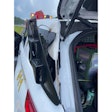Given the increasing sophistication of today’s criminals and crime, it’s no surprise that today’s law enforcement agencies are fighting back by employing a staggering array of tools. This includes not only computerized hardware and software, but weapons (including less-than-lethal options, of course), training and vehicles, among other items.
When it comes to modes of transportation, the venerable patrol car is the most common choice as it fills the widest set of requirements. But different tactical situations often demand different solutions, and when it comes to transport there are four-wheel-drive SUVs, motorcycles, even helicopters. In rural areas and even in certain urban scenarios, horses are also called upon.
But more and more, ATVs (all-terrain vehicles, most often comparatively small, one-person machines sporting four low-pressure, high-flotation tires, motorcycle-type engines and handlebar steering) are being chosen to deploy officers quickly. Highly maneuverable, relatively quiet and able to traverse some of the roughest terrain around, ATVs have been popular with both recreational/outdoor riders and farm/industrial users for many years -- and for many of the same reasons. The fact that ATVs are also fun to ride is, of course, the most compelling reason for recreational riders to purchase them, and also undoubtedly a well-cloaked motive behind many farm/industrial sales.
As many new ATV owners have discovered, however, the machines are unlike dirt bikes, cars, trucks or most other motorized vehicles. The only real comparison, according to those who have experience with both, is to snowmobiles.
Though easy to ride at a sedate pace on flat ground, those who attempt to approach an ATVs performance potential quickly learn that the machines demand techniques that they’ve never learned or imagined. The result can be simply embarrassing or it can be a serious injury. In either case, proper training is what’s called for.
And that’s what the Snowmobile Safety Institute (SSI) offers: training in the proper riding techniques of not only snowmobiles but also ATVs, especially in the role of a law enforcement officer’s vehicle. A dozen officers recently underwent such training in the SSI's ATV Police Patrol Operations course conducted near Woodland Park, Colo.
"This course is basically directed at law enforcement officers and fish and game officers who are directly involved in enforcement of ATV laws and regulations. Also [for those involved] in any backcountry patrol for fish and game violations," SSI Executive Director Garry Forman explains.
"This course is 100% developed [for] and devoted to emergency and police vehicle operational skills to improve rider skills for the officer," Forman says.
Many officers think they’ll be able to handle an ATV, but the skills used in purely recreational riding are very different from the skills and techniques necessary for law enforcement and search and rescue missions.
Forman continues, "Probably one of the most difficult techniques for an officer to understand when operating an ATV is what his riding abilities are and what the capabilities of his machine are. It's very hard."
Questions that don’t always occur to officers riding ATVs, but need to, include, "How does weight and the capacity of the equipment that we have to put on these machines? How's that going to affect the handling dynamics of this vehicle when they need to operate it?" says Forman.
"The more weight you put on this vehicle affects its handling. And that’s not just the weight of the vehicle; that includes the fluids you put into it, the weight of the officer -- the duty gear (which can weigh anywhere from 15 to 20 pounds) rescue and other operations equipment, which can range anywhere from another 30 to 100 pounds, based upon the operation that the officer’s going to be in. All that increases their center of gravity, and when we increase the center of gravity on these types of vehicles, it dramatically influences the handling capabilities of this machine, and the officer has to understand what those capabilities are. He needs to reduce speed, he needs to make this machine do what they need to do when they need to do it."
He continues, "Most officers are new officers in an ATV role and will be just like most recreational riders -- they ride the machine. Here, we’re not riding the machine -- we’re making this machine do what we want it to do when we need to do it," he concludes.
Instruction at SSI starts with the basics -- where the controls are and what they do, pre-ride machine checks, rider positioning, even recommended pre-ride stretching -- and moves on to increasingly difficult riding drills/techniques. Forman and his assistants even teach the proper way for an officer to both mount and dismount the ATV. Dismounts include the standard "patrol" and the more urgent "tactical" variations, both beginning by stopping the machine and the officer planting his foot on the ground before pulling or pushing himself with his left hand on the handlebar. Getting that foot on the ground helps ensure more stable footing.
Some of the instruction takes place in the classroom, but most of the four-day course is done in the field. There is, after all, nothing like actually riding -- correctly and under the watchful eyes of the instructors -- to improve your riding.
Other skills taught include using the ATV for cover and/or concealment (much harder than with a larger vehicle), how to turn it around should you be unable to make it up a hill, pulling over others and machine positioning while approaching a suspect. But these were by no means the only skills the officers I spoke with learned during the course. As the students discovered, four days was barely enough to take it all in -- and this is with a minimum of weapons tactics presented. Most instruction dwelled on tactical riding procedures once the basics were down.
And what did the officers think of the course? Larry Marlow, an officer with the U.S. Forest Service from Wyoming who’s responsible for patrolling an area of 500,000 to 750,000 acres, had some ATV-riding experience prior to the course, like most of the officers. He begins, "I've been riding ATVs for about nine years now," in addition to the horseback riding and snowmobiling skills his beat has demanded. "The only training that I’ve had is a basic course put on by the Forest Service that includes skills such as the "K" turn that we did here, some of the turning techniques, this type of thing -- but nothing as advanced as we did here."
Jeff Kramer, a deputy sheriff in Colorado’s El Paso County (which includes Colorado Springs), agrees, adding, "What was great to see is that the techniques we learned were applied to what we might expect to see in the police world doing those tactical dismounts, drawing the weapon, putting it all into motion with what we might expect in the field.”
Kramer's teammate in the class, fellow El Paso County deputy sheriff Sean Hartley, admits getting the most out of the tactical potential of the instruction: "For me, I’m always thinking tactics, being a SWAT cop. If I were to be on an ATV, it’s all about tactics: How am I going to position myself? How do I dismount and go to draw my weapon, things like that. Yeah, it’s a kick in the butt to ride, kick around some dirt. But tactics are, personally, what will stick in my mind."
Of course, not every agency has put ATVs into use extensively yet, even if they do have them available. As Kramer reveals, his department doesn’t have them -- he rode a machine borrowed from the local office of the USFS -- but he can envision how they’d be used: "Our function for ATVs with the El Paso County Sheriff's Office would be to take those vehicles and deploy them into areas and patrol into areas that are not often patrolled because of how remote they are. [ATVs] obviously give us that versatility that we can get into those areas and do some enforcement and some patrol checks."
At the end of the course, many of the officers, while enjoying their enhanced skill level, knew that they’d benefit from even further training. Kramer concludes, "What I plan on doing, is to continue to seek out additional training." And the SSI can certainly fill that order, thus producing even better trained cops.
Five Favorite ATV Accessories:
- Rack-mounted storage boxes-hold more gear more securely.
- Emergency and auxiliary lights-help increase visibility and vision.
- Scabbard for shotgun or rifle-a handgun is handy to have before transitioning to a long gun in high-risk scenarios.
- Radio-maintaining communications need not cease just because you're ATV-mounted.
- Winch and tow strap-invaluable when you must extricate yourself or others.
Five tips for ATV officers:
- Get professional training from an experienced, reputable company or instructor.
- Practice the techniques and drills learned (with your patrol partner, if possible).
- Always wear the correct safety gear (helmet, eye protection, etc.) as well as required duty gear.
- Know and ride within your own - and your machine's - capabilities.
- Ensure that your ATV is properly maintained.
Mark Kariya is a freelance writer and photographer who loves riding ATVs and dirt bikes. Oh yeah, he’s been writing about them for more than 20 years, too.

















